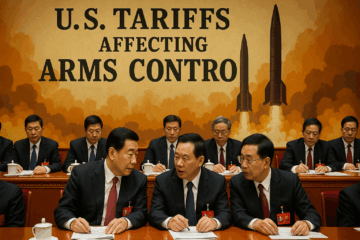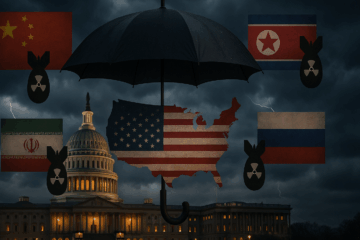The United States stands at a critical juncture. As tensions rise and threats from Russia, China, North Korea and Iran evolve, it is paramount that the nation ensure it possess the strength needed to defend against adversary aggression. Central to this effort is the need to foster competition in key areas of the defense industrial base, including naval shipyards, intercontinental ballistic missile (ICBM) manufacturing, nuclear weapons design and manufacturing, and aircraft production. Such investments are not only vital for maintaining America’s military edge but also for safeguarding our nation against emerging threats.
Encouraging competition and redirecting investments away from major defense contractors such as Raytheon, General Dynamics, Lockheed Martin, Boeing, and Northrop Grumman, towards emerging companies (Space X, Looking Glass, Kodiak) with innovative approaches and cost-effective capabilities, can enhance national security. This shift has the potential to lower defense procurement costs, provide technological advantages, and reduce the monopolistic control and price gouging these major contractors have over government defense contracts.
Shipyards
Naval shipyards are the backbone of maritime defense, yet their capacity and efficiency were challenged in recent years. Currently, the top military shipbuilding corporations are General Dynamics, Huntington Ingles, Lockheed Martin, Northrop Grumman, and Raytheon. The nation cannot continue to rely on these companies to produce cost-effective, on-time results for the Navy. The simple truth is almost every contract awarded to these companies ends up over budget and delayed years.
By fostering competition among up-and-coming companies we can revitalize our shipbuilding industry, introducing new technologies and innovative approaches that improve cost-effectiveness and speed of construction. Paramount to the issue, the US needs to invest in developing additional shipyards to combat the growing Chinese capabilities as a new maritime superpower. This will not only strengthen the US naval fleet, but also allow the Navy to counter the rising threat and reverse the nation’s downward trajectory, creating jobs and stimulating economic growth.
ICBM Manufacturing
Enhancing ICBM manufacturing capabilities is essential for maintaining a strong nuclear deterrent. Currently, Boeing is responsible for producing key components for US and UK Trident II (D5) missiles and US Minuteman III ICBMs, while General Dynamics manufactures key components for US and UK Trident II (D5) missiles. Lockheed Martin plays a role in upgrading Trident II (D5) missiles for the US and UK, as well as Minuteman III, and also manages a UK nuclear weapons laboratory along with several US nuclear weapons facilities.
Northrop Grumman is involved in similar activities, including Trident II (D5) missile upgrades for the US and UK, Minuteman III, and management of some US nuclear weapons facilities. Additionally, in 2020, Northrop Grumman was awarded a sole-source $13.3 billion contract for engineering and manufacturing Sentinel missiles to replace the current arsenal of 400 deployed Minuteman III ICBMs. They have also acquired Orbital ATK, which has similar involvements.
Unfortunately, every nuclear modernization project went over budget and was delayed despite tens of billions of dollars pledged towards the modernization goal. Ultimately, increasing competition in this sector can spur innovation, resulting in more dependable and advanced missile systems at a more cost-effective price. Encouraging companies like SpaceX, Blue Origin, and Virgin Galactic to invest in defense manufacturing of rocket technology, possibly through government contracts, could drive progress. Furthermore, diversifying the manufacturing base can mitigate the risk of supply-chain disruptions, ensuring a consistent supply of these critical weapons.
Nuclear Weapons Facilities
Nuclear weapons design and manufacturing facilities are another area where competition can yield significant benefits. Currently, the Pantex Plant in Amarillo, Texas, is the only nuclear weapons assembly and disassembly facility. The nation needs more than a single facility for this task. This is a national security concern. Any issue with this facility, and assembly and disassembly of nuclear weapons is hampered. By encouraging competition, the nation can modernize the nuclear arsenal, ensuring it remains safe, secure, and effective. Moreover, competition in the assembly and disassembly process can lead to cost savings, which enables the nation to allocate resources to other pressing defense needs.
Aircraft Manufacturing
The need for a robust aircraft manufacturing capability is paramount. Navy Adm. John C. Aquilino, the head of US Indo-Pacific Command said, in recent congressional testimony, that China has the world’s largest navy and is soon to be the world’s largest air force. With potential adversaries investing heavily in advanced aircraft, America must maintain a competitive edge. With the looming prospect of having to fight and fund a three-front war (Ukraine-Russia, Israel-Iran, and China-Taiwan), the US needs to maintain its ability to obtain and provide air superiority in whatever conflicts it enters.
By fostering competition, we can spur innovation in aircraft design and production, ensuring air superiority in future conflicts. Investing in cost-effective drone swarms and continued advancements of our 5th- and 6th-generation fighters is essential. Furthermore, the US must increase the number of strategic stealth bombers in its arsenal from 20 to 200 to 300. Development and purchase of 100 B-21 Raiders is a good start, but there needs to be more competition or manufacturing supply-chain issues will continue to plague this modernization process.
Fallout Shelter Investments
Investing in a more robust fallout shelter system is crucial for ensuring the safety and protection of the American population in the event of a nuclear attack or other catastrophic event. While government efforts have historically been the primary driver of fallout shelter development, there is also a role for private entities to play in this important endeavor.
During the Cold War, the United States undertook a massive effort to build fallout shelters in anticipation of a potential nuclear conflict with the Soviet Union. The government constructed thousands of public fallout shelters in buildings such as schools, government offices, and subway stations. Private individuals and organizations also built their own shelters to protect against nuclear fallout.
The government entities involved with fallout shelters are the Federal Emergency Management Agency (FEMA) and the Department of Defense (DoD). FEMA is responsible for coordinating federal government efforts in disaster response and recovery, including the development and maintenance of fallout shelters. The DoD is involved in the construction and maintenance of fallout shelters, particularly those designed to protect military personnel and assets such as the Cheyenne Mountain Complex.
The primary private entities involved in developing and manufacturing fallout shelters are Atlas Survival Shelters, Rising S Company, and Hardened Structures. Atlas Survival Shelters specializes in the design and construction of underground shelters for protection against nuclear, biological, and chemical threats. Rising S offers a range of underground bunkers and shelters for protection against various threats, including nuclear fallout. Similarly, Hardened Structures provides custom-designed shelters and bunkers for protection against nuclear, biological, and chemical threats.
While the number of public fallout shelters declined since the end of the Cold War, there are still thousands of designated shelters across the country, although most are unknown, rundown, and primarily used for storage. They should be refurbished and updated to properly address the sheer number of citizens that would be required to shield from not only the initial blast, but any possible fallout.
Ultimately, it is essential that efforts to develop and maintain fallout shelters continue, as the threat of nuclear conflict remains a major concern in today’s world. By fostering competition in this sector, the nation can drive innovation and ensure that every American has access to adequate protection in the event of a nuclear attack or other catastrophic event.
Conclusion
The United States must prioritize investments in fostering competition and innovation across key areas of the defense industry to strengthen national security. By redirecting investments from major defense contractors towards emerging companies with cost-effective military capabilities, the nation can enhance its military edge, reduce costs, and mitigate the near-monopolistic control of government defense contracts.
Revitalizing naval shipyards, enhancing ICBM manufacturing capabilities, modernizing nuclear weapons facilities, advancing aircraft manufacturing, and investing in a robust fallout shelter system are critical steps in safeguarding our nation against emerging threats.
By encouraging competition and diversifying the manufacturing base, the nation can drive innovation, ensure a continuous supply of critical weapons, and maintain a technological edge over adversaries. It is imperative that the nation act now to secure the future of our national security.
Aaron Holland is an Analyst at the National Institute for Deterrence Studies. The views expressed in this article are the authors own.
About the Author

Aaron Holland
Aaron Holland is an Analyst at the National Institute for Deterrence Studies.





Hi Aaron, thanks for your article!
I wanted to bring some perspective on your section about nuclear weapons facilities. While I am in agreement the defense sector needs more competition, the nuclear security enterprise does not function in a similar capitalistic/competitive manner that DOD procurement does. All DOE/NNSA sites are government owned/contractor operated. This would mean that even the addition of another assembly/disassembly plant would not be capable of reducing overall costs for building nuclear weapons. The two sites would never be competing with each other to see which can assemble/dissemble warheads the ‘cheapest.’ Further, the cost to build another nuclear site is astronomical. Take a look at pit production in Savannah River, turning the old MOX facility into a pit production site is going to cost at least $6.9 – $11.1 billion and many years to do so. There is limited political capital to even support our current modernization plans.
I am rapidly becoming one of Aaron Holland’s nuclear deterrence fans! This essay reveals his usual excellent quality offering of context, insights, & actionable recommendations. All with concise compelling clarity — the 3 C’s of good nonfiction writing. I’m delighted & privileged to have co-authored some articles with Aaron for NIDS’s Global Security Review. (Some of these were posted recently, some are in the GSR submissions hopper with Editor Adam Lowther, and some are now in the research & drafting stage.)